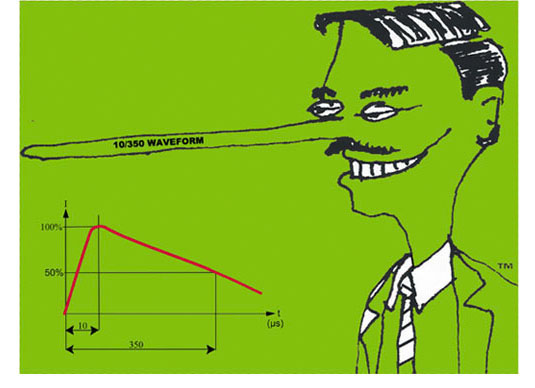TEN350 The waveform that hijacked the IEC lightning standards
Let's just say there's been some exaggerating going on...
The claim that the 10/350 waveform is the truest, best, and only representation of direct lightning is an urban legend about as true as the one about the moon being made of green cheese. Shedding light on this myth is one of the purposes of this website.
 The planet's first “waveform wars” have raged over the past 20 years or so, occasioned by certain mandatory requirements for testing surge protective devices (SPDs). The test is the IEC's Class I Test employing a 10/350 μs waveform together with high levels of current, charge transfer, and specific energy. Proponents pointed to Karl Berger and CIGRE as evidence of their authority to use those parameters. Opponents argued that Berger's findings were being misinterpreted, that the 10/350 waveform didn’t duplicate real lightning, and no one could show an actual recording of one. The venerable Francois Martzloff led an unsuccessful attempt to reconcile these two viewpoints. By 2013, faced with the general trend to harmonize all US standards with those of the IEC, most opponents of the 10/350 waveform test had sunk into various degrees of apathy on the subject.
The planet's first “waveform wars” have raged over the past 20 years or so, occasioned by certain mandatory requirements for testing surge protective devices (SPDs). The test is the IEC's Class I Test employing a 10/350 μs waveform together with high levels of current, charge transfer, and specific energy. Proponents pointed to Karl Berger and CIGRE as evidence of their authority to use those parameters. Opponents argued that Berger's findings were being misinterpreted, that the 10/350 waveform didn’t duplicate real lightning, and no one could show an actual recording of one. The venerable Francois Martzloff led an unsuccessful attempt to reconcile these two viewpoints. By 2013, faced with the general trend to harmonize all US standards with those of the IEC, most opponents of the 10/350 waveform test had sunk into various degrees of apathy on the subject.
In 2013 CIGRE Workgroup C4.407 published an update to Berger's works, entitled Lightning Parameters for Engineering Applications. The findings in CIGRE's Technical Brochure 549 negate the foundation of the 10/350 waveform and the Class I test. It is now no longer possible to make any kind of case for mandatory use of the 10/350 test waveform in standards. In its thoroughly scholarly way, CIGRE has left no wiggle room. This will undoubtedly irk those with vested interests while adding spring to the steps of those to whom 10/350 never made much sense. One way or another, the IEC lightning protection standards can now, in fact must, undergo their needed reformation. Only then can a true harmonization occur between IEC and ANSI lightning protection standards.
Back to Home Page